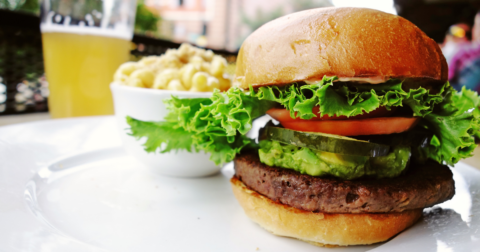News
RFK’s New Dietary Guidelines Delayed Again, Amid Concerns
Diet•6 min read
Reported
We investigated why fast food chains can’t seem to nail plant-based meat, and here’s what we found.


Words by Jessica Scott-Reid
When my friend Chad opened his new burger shop two years ago, he was eager to offer plant-based meat options. “We had so many requests,” he tells Sentient, and he wanted to get it right. He entrusted me, his vegan pal, to come test out the new burger on the menu. But, unfortunately, despite my buddy’s best efforts, what I bit into was a mushy mess. I let my friend know, and he went back to the fryer to figure it out. “Ruined many a burger trying to get them right” he says, as he attempted different ways to quickly cook the patties from frozen.
Turns out my friend’s experience isn’t unique. Fast food consumers commenting on social media, and some who spoke with Sentient, have also described similar mushy mouthfuls of plant-based burgers at fast food chains. The donut chain Dunkin’ eventually canceled their plant-based patty and sausage, while McDonalds scaled back their McPlant. But what’s to blame for quality control of plant-based meat in fast food chains, and is there a solution?
“It tastes to me like they microwave their burgers,” says Michelle Oberg, a consumer who has tried plant-based patties at fast food chains. Oberg also cooks Beyond Meat and Impossible Foods burgers at home “in a pan or on the grill,” and says in her own kitchen, “they are so much better.”
Back in 2018, the A&W chain in Canada (different from the U.S. restaurant by the same name) was the first major fast food operation in the world to offer the Beyond Burger. By most accounts it was a hit, as journalists, bloggers and Reddit users sang the new products’ praises. A&W sold out of the burgers nationwide within the first few weeks, part of a larger plant-based trend that kicked off that year and continued to gain steam for the next few years.
I was a big fan too at first, but then something changed. The burger got soft. And not just a few times, but everytime I ordered. And not just at A&W, but Burger King’s “flame grilled” Impossible Whopper, too. I found myself bringing the burgers home from the drive through, even after requesting well-done, only to have to dismantle the patty and throw on a pan for further cooking. And I’m not the only one. While my research isn’t scientific, I can find plenty of examples of online complaints that match my experience.
“I always have to tell them to cook it to well done, otherwise it’s just mush,” wrote one user on X, about their meal at A&W Canada. “Not sure why they can’t just do it properly without being told in advance. Would hate for people to stop getting it because they don’t cook it properly,” they add.
It’s not just A&W Canada either. In the U.S., Carl’s Jr. has served the Beyond Burger since 2019, while Burger King serves the Impossible version of the chain’s Whopper. For both, some online critics have complained their vegan burgers are undercooked. “Is this what the Beyond Meat burger is supposed to look like?” wrote another X user to the restaurant. “Outer edge was crisp, but the flat part (that I assume should actually touch the grill) seemed totally underdone and mushy.” And in a review of Burger King’s Impossible Whopper, another X user writes: “It tasted 85% like a Whopper,” but “the main issue was indeed the patty […] Texture was mushy and unsatisfying.”
I want these plant-based brands to succeed. After all, curbing how much meat some of us eat would help countries in the global north reduce food-related emissions, and one way to do that is to replace some beef burgers with plant-based alternatives. The problem is, less-than-perfectly prepared vegan patties could turn off first-time customers, making it tougher for this food system solution to succeed.
Oberg puts it more bluntly: “I dislike that people may get the wrong impression that these burgers suck.” Fast food chains have a massive reach, and a huge capacity to reduce climate and animal welfare impacts from meat. And those of us who cook Impossible and Beyond meat at home know just how deliciously meaty these burgers can be, when done right. So what are fast food restaurants getting wrong? And why won’t they talk about it? Sentient reached out to Beyond Meat, Impossible Foods, Carl’s Junior and A&W Canada, but none of these companies offered comment.
At least one plant-based foods expert has an idea. Efforts to make plants taste and feel like animal meat are not quite perfected yet, Alejandro G. Marangoni, PhD, professor and researcher of food science at the University of Guelph tells Sentient, the persistent, tricky challenges for these companies become glaringly obvious in fast food settings. For example, both Beyond and Impossible rely on an ingredient to bind everything together called methylcellulose, which Marangoni says can be finicky at the kinds of varying temperatures common in fast food service.
But before we get into that, let’s first set the record straight about methylcellulose, which has been the focus of some meat industry marketing misinformation campaigns to scare consumers by calling it “synthetic” “unhealthy” “processed chemicals.” The ingredient is perfectly safe for most consumers in moderation, and is both FDA approved and non-toxic. As Sentient previously reported, methylcellulose is a compound derived from plant fibers used to bind or thicken all kinds of foods, such as breads, cakes, ice creams and chocolate. It’s not scary — even though the meat industry would like consumers to think it is. After all, no one seems to be campaigning against the use of methylcellulose in many gluten-free products.
Marangoni explains that plant proteins are not naturally “sticky” the way muscly meats are, and thus require a binder to keep them together. As a result, companies turn to the synthesized plant fiber methylcellulose or sometimes wheat gluten (though that’s somewhat less popular as many consumers continue to avoid it). Methylcellulose, he says, gives the burger “some structure and some chew,” but the problem is it’s also “reversible,” meaning that the structure can change with fluctuating temperatures. In other words, a nice firm patty can turn to mush.
Plant proteins also do not retain water as well as animal protein, says Marangoni. “The water binding capacity of plant proteins and starches is poor, and it gets released very easily,” he explains, which can leave the product seemingly wet, a feature that’s not so desirable in a burger. “A way to have it not so mushy then is cooking and drying it, cooking and drying it until you have something that is less wet,” he says. But then, the problem becomes, consumers complaining their burgers are no longer juicy, he says. This is the challenge plant-based meat companies are trying to solve, at least if they want to succeed in mass food service operations.
Paul Zalecki, a plant-based chef and co-founder of Vegan Fried Chick*n brand in the UK, has also seen mushy plant meat at some fast food locations in the region. But proper preparation can go a long way, he says. “The key is keeping the product at [the right] temperature,” and serving and eating plant-based meats right after cooking. If the burger has to go under a heat lamp or is delayed being served, Zalecki says he would put the plant based dish “back in for cooking to get it to 62 degrees [143.6 f] and higher.”
This isn’t so easy to do in fast food environments, however. That’s why some chefs, scientists and product developers are looking at other binding ingredients to ensure more consistent quality. Zalecki is looking into “citrus fiber or Konjac [a high fiber root vegetable],” he says, “that give the product texture on cooling.”
Another problem may be that these restaurants simply aren’t following directions when they cook up plant-based meat, which is a product that requires some care. Fast food restaurants often cook burger patties from frozen, especially plant-based patties that are ordered less frequently. Yet in its online cooking instructions, Beyond Meat recommends thawing patties first for better texture, and does not recommend deep frying. Beyond Meat also recommends upping the total cooking time to at least 12 minutes (minimum 4 minutes per side, adding at least two more per side when frozen), ensuring internal temperatures reach at least 165 degrees fahrenheit.
On a recent trip to my local A&W Canada, where I once again ordered my Beyond Burger well done, I was sadly served my burger in well under ten minutes, and it was once again undercooked.
While it’s clear that there is still work to be done to make plant-based burgers more fast food friendly, perhaps for now the solution is simple: they just require a few more minutes on the grill than their animal-based counterparts. After waiting decades for food innovation to present us with a plant-based product that is both earth and animal-friendly — one that truly mimics the burger experience — I suspect many conscious consumers are willing to pull over and wait a few more minutes for a fast food order. I’ll be sure to let my friend Chad know, and we can only hope the fast food sector begins to take note, too.